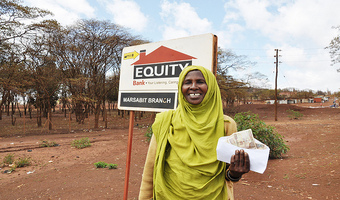 Kenyan pastoralists are recording steady supply of livestock even after dry spells a departure from the past, thanks to a livestock index insurance designed to compensate them for livestock losses caused by drought.
Kenyan pastoralists are recording steady supply of livestock even after dry spells a departure from the past, thanks to a livestock index insurance designed to compensate them for livestock losses caused by drought.
The model which sees them pay premiums to be compensated once drought strikes has been a silver bullet four years since it was established.Abdub Waqo Jaldesa is a pastoralist and peasant farmer in Central Division of Marsabit District. In his mid-30s, he is the father of two children, but in recent years has watched his 40-strong herd of cattle diminish, killed by successive droughts.
“It was a problem that has no solution and the only hope we had was God,” said Abdub. But in 2010, at the launch ceremony of Marsabit Equity Bank branch, he heard the announcement that a programme of Livestock Insurance was to be launched in Marsabit.
The insurance turned out to be a reality: the International Livestock Research Institute (ILRI), in collaboration with UAP insurance and Equity Bank, rolled out a pilot scheme in Marsabit. ILRI had spent four years working on the project, through research and market surveys, to achieve a commercially sustainable solution.
Abdub was one of the farmers who took insurance cover for their animals under the programme, and three months ago, he has received compensation payment since 2011.
The scheme is an innovative model designed to help pastoralists recover from droughts, by delivering payments to cover the loss of their cattle, goats, sheep and camels. The UK aid funded initiative is now compensating more than 600 insured herders in the Marsabit District of northern Kenya, where some have lost as much as a third of their animals.
It works by keeping track of livestock levels using freely-available satellite data to assess the state of pastures and to accurately predict animal deaths. When the images show that pastures have dried up, herders can claim compensation for animals that have died as a result - based on the computerised predictions of the likely number of deaths.
By working as an index, based on the condition of pastures, the new system bypasses the high costs and difficult logistics previously needed to confirm animal deaths among herds that roam across vast distances in extremely remote areas.
Abdub, who insured two of his cows, paid a premium of Sh487.50 per head of cattle. The policy he took was for a period of one year, covering the cows from February 2011 to February 2012. In October, he received a sum of Sh1,650 per head of for the two animals he insured. “For us in Gadamoji and Central Division, we were told the intensity of drought was 25 per cent and the amount was calculated based on that,” he said. Impressed by the arrangement he has continued with the annual arrangement.
Though Abdub currently owns about 20 heads of cows he insured only two of them because of lack of money and his uncertainty about the scheme. “I have more animals than I insured: this drought I lost six cattle to drought and if I could have insured all twenty, today I could not have been counting loses,” he said.
He was, however, the only one who insured his cattle in his village of over 100 households, almost all of them with livestock. In 2010, when the programme was first launched, almost everyone in his village insured their livestock, but the level of drought that year didn’t reach the required threshold to trigger payments. In 2011, many of the pastoralists saw it as another scheme to defraud them of their money and decided not to renew their policies.
“It seemed a risky gamble when I decided to give it a try again and I became the laughing stock for many, and that is why I insured only two. But next time I will insure all my animals,” said Abdul. “In 2010, I insured about 10 heads of cattle and I didn’t receive any compensation and that discouraged me from insuring a larger number.”
However, many pastoralists still don’t understand the insurance and how it works. Abdub says they expected it to be an investment from which they would get payback with profit after one year, and when they didn’t receive anything in 2010 they were disappointed. Yet his own experiences and the strong risk of drought in the area mean it is an investment worth making for pastoralists.
“Drought insurance is one important way to help livestock keepers maintain food security even in very harsh environments. This is asset insurance for animals that are the centrepiece of livelihoods, providing a stream of income and nutrition for years and years,” said Dr Andrew Mude of ILRI.
The failure of short rains in many parts of the country and consecutive poor rains for the previous two years led to huge losses for pastoralists, leaving over three million people dependent on food aid last year alone. Northern Kenya has been the worst affected area. In 2009, drought killed 300,000 goats and sheep in Turkana District.
The new insurance has been launched under the Global Index Insurance Facility (GIIF) of the private sector arm of the World Bank, The International Finance Corporation.
















Comments powered by CComment